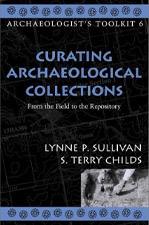Book Review
Curating Archaeological Collections: From the Field to the Repository
By Lynne P. Sullivan and S. Terry Childs. Archaeologist's Toolkit Vol. 6, Walnut Creek, CA: AltaMira Press, 2003; 160 pp., appendix, bibliography, index; cloth $65.00; paper $22.95.
 |
Any registrar or collections manager knows that the care of archeological collections is a continuing challenge because of understaffing, underbudgeting, and overcrowded storage areas. This problem is pervasive throughout the museum field. Cogently written and well presented, Curating Archaeological Collections provides a background on how this crisis started, how it got out of hand, and what can be changed. For archeologists and museum professionals this book provides direction towards ensuring the preservation of archeological collections.
The authors emphasize that proper care and management of archeological collections is the responsibility of many including federal, state, and local agencies; historical societies; and archeologists. The authors provide an excellent history of archeological curation in order to show what has led to the current crisis. As a result, the authors focus on the management aspects of curation.
The authors believe that archeologists need to be aware of "the archeological collection" before they actually collect it. Stressing preparation and planning for artifact care before going into the field, the authors show how archeologists can develop a significant and meaningful collection. While written with the archeologist in mind, this book is useful for curators as well. It helps them understand the complexities that make up archeological collections. The two groups need to coordinate and develop shared goals because significant collections consist not just of the artifacts, but also associated records.
While the authors devote a chapter to repositories and their function and standards, they do not elaborate on what some call "official" repositories and their accountability. Most states have official repositories, such as state museums, where all professionally excavated archeological collections that meet certain criteria are deposited. The authors note that curators and registrars should try to work with the archeologists and State Historic Preservation Offices to establish criteria for the eventual curation of a collection. This kind of relationship early in the curation process is critical to addressing some of the current problems.
Curation policies and guidelines on collections care and management must also be communicated to field archeologists well in advance of projects. Discussions among the repository, archeologists, and state agencies can help shape project research designs to focus more on curation. With that said, any repository needs to be vigilant in their policies and guidelines when accepting archeological collections.
A good deal of literature exists on the subject of curating archeological collections. However, this book goes beyond mere reference work and provides direction towards resolving the current crisis. Presently, there are resources generated by committees, discussion groups, and conference sessions devoted to the subject that may not get disseminated to repositories, historical societies, and field archeologists. With the publication of Curating Archaeological Collections and the entire Toolkit Series from AltaMira Press, a much wider audience is reached.
This book has an extremely handy appendix containing a list of Internet sites that provide useful information on curation policies, laws, and regulations. References provide another research avenue for both contract archeologists and museum professionals to examine literature on collections care and management.
This book is useful to any registrar, collections manager, curator, and field archeologist. It should also be used in archeology methods and cultural resource management classes. The valuable lessons presented will assist archeologists when planning excavations and processing artifacts, and help repositories better care for and manage their collections. With ever increasing and encroaching development, the need to improve communication and training in the management, collection, and care of our diminishing cultural heritage is urgent. As the authors state, "it's about what our progeny will inherit."
Gregory D. Lattanzi
New Jersey State Museum
